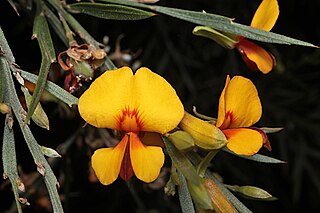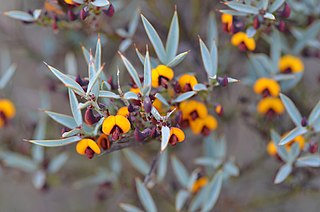
Jacksonia sericea, commonly known as waldjumi, is a species of flowering plant in the family Fabaceae and is endemic to the south-west of Western Australia. It is a spreading to prostrate shrub with greyish-green branches, straight, sharply-pointed side branches, leaves reduced to scales, orange flowers with red markings, and woody, densely hairy pods.

Jacksonia sternbergiana, commonly known as stinkwood, is a species of flowering plant in the family Fabaceae and is endemic to the south-west of Western Australia. The Noongar peoples know the plant as kabbur, koorpa or mondurn. It is an erect or weeping shrub or tree with dull green branches, straight, sharply-pointed side branches, its leaves reduced to scales, yellowish-orange flowers, and woody, hairy pods.

Daviesia triflora is a species of flowering plant in the family Fabaceae and is endemic to South West Australia. It is a rush-like, leafless shrub with many stems, and orange-yellow and dark flowers.

Jacksonia lehmannii is a is a species of flowering plant in the family Fabaceae and is endemic to the south-west of Western Australia. It is an erect to prostrate or spreading, spindly shrub with greyish-green branches, sharply-pointed side branches, its leaves reduced to scales leaves, yellowish-orange flowers with orange-red markings, and woody, hairy pods.

Jacksonia horrida is a species of flowering plant in the family Fabaceae and is endemic to the south-west of Western Australia. It is an erect or spreading to prostrate, bushy shrub with greyish-green branches ending in short, flattened, sharply-pointed side branches, the leaves reduced to scales and the flowers scattered and yellow-orange with red markings.

Daviesia nudiflora is a species of flowering plant in the family Fabaceae and is endemic to the south-west of Western Australia. It is a bushy shrub with sharply pointed, egg-shaped to elliptic or oblong phyllodes, and yellow-orange flowers with reddish-brown markings.

Daviesia hakeoides is a species of flowering plant in the family Fabaceae and is endemic to the south-west of Western Australia. It is a shrub with many tangled stems, scattered sharply-pointed phyllodes and yellow or orange and dark red flowers.

Jacksonia anthoclada is a species of flowering plant in the family Fabaceae and is endemic to the south-west of Western Australia. It is an erect, single-stemmed shrub with hairy, elliptic to egg-shaped phylloclades with sharply-pointed edges, yellow-orange flowers with red markings, and hairy, woody pods.

Daviesia ovata, commonly known as broad-leaf daviesia, is a species of flowering plant in the family Fabaceae and is endemic to a restricted part of the south-west of Western Australia. It is a dense, bushy, glabrous shrub with egg-shaped to elliptic phyllodes and orange and maroon flowers.
Daviesia podophylla, commonly known as buggery bush, is a species of flowering plant in the family Fabaceae and is endemic to the south-west of Western Australia. It is an openly-branched, glabrous, glaucous shrub with many often sharply-pointed branchlets, triangular phyllodes with a sharp point on the end, and orange-yellow, dark red and black flowers.

Daviesia trigonophylla is a species of flowering plant in the family Fabaceae and is endemic to the south of Western Australia. It is an erect, bushy shrub with elliptic or egg-shaped phyllodes that are triangular in cross-section, and orange, dark red and maroon flowers.

Jacksonia aculeata is a species of flowering plant in the family Fabaceae and is endemic to the northern Australia. It is a spreading shrub with sharply-pointed, hairy, short side branches, leaves reduced to scales, lemon-yellow flowers, and woody, hairy pods.

Jacksonia alata is a species of flowering plant in the family Fabaceae and is endemic to the south-west of Western Australia. It is a tufted, semi-prostrate to erect shrub with flattened branches, sharply-pointed side branches or phylloclades, leaves reduced to narrowly lance-shaped scales, yellow-orange flowers with a red "eye", and woody, densely hairy pods.

Jacksonia angulata is a species of flowering plant in the family Fabaceae and is endemic to the south-west of Western Australia. It is a tufted, spreading to prostrate shrub often with zig-zagged branches, sharply-pointed side branches or phylloclades, leaves reduced to broadly egg-shaped scales, yellow-orange to orange flowers with a red "eye", and woody, densely hairy pods.

Jacksonia arenicola is a species of flowering plant in the family Fabaceae and is endemic to the south-west of Western Australia. It is an erect, broom-like shrub with densely hairy, sharply-pointed phylloclades, yellow-orange flowers with red markings, and woody pods that are hairy at first, later glabrous.

Jacksonia argentea is a species of flowering plant in the family Fabaceae and is endemic to the far north of Western Australia. It is an erect, silver-grey shrub with flattened, narrowly lance-shaped to narrowly elliptical cladodes or phylloclades, bright yellow flowers, and woody hairy pods.
Jacksonia arida is a species of flowering plant in the family Fabaceae and is endemic to Western Australia. It is an erect or prostrate shrub with tangled branches, sharply-pointed branchlets, yellow-orange to orange flowers, and woody pods.
Jacksonia arnhemica is a species of flowering plant in the family Fabaceae and is endemic to the Northern Territory. It is an erect, densely branched, delicate shrub, the end branches sharply-pointed phylloclades, with yellow flowers, and woody, hairy pods.
Jacksonia calycina is a species of flowering plant in the family Fabaceae and is endemic to the south west of Western Australia. It is an erect or straggling shrub with sharply pointed end branches, yellow-orange flowers with red and yellow markings, and woody, hairy pods.

Jacksonia capitata is a species of flowering plant in the family Fabaceae and is endemic to the south of Western Australia. It is a spindly, low-lying to erect ascending shrub with curly, greyish green, cylindrical branches, the leaves reduced scales, and yellow-orange and red flowers in clusters at the ends of the shoots.
















